Grace Robert. Advanced Blowout and Well Control
Подождите немного. Документ загружается.

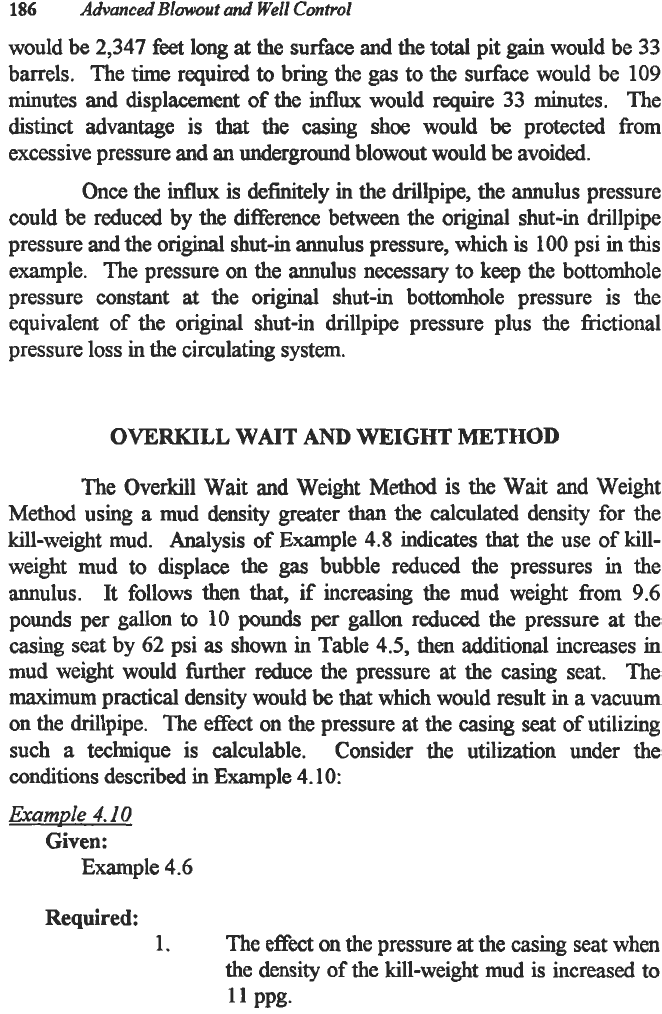
186
would be
2,347
feet
long
at
the surface and the
total
pit
gain
would be
33
barrels. The time required
to
bring the gas to the surface would be 109
minutes and displacement
of
the
influx
would require
33
minutes. The
distinct advantage is
that
the casing shoe would
be
protected from
excessive pressure and an underground blowout would
be
avoided.
Once the influx is definitely in the drillpipe, the annulus pressure
could be reduced by the difference between the original shut-in drillpipe
pressure and the original shut-in annulus pressure, which
is
100
psi in
this
example. The pressure on the annulus necessary to
keep
the bottomhole
pressure constant
at
the original shut-in bottomhole pressure is the
equivalent of the original shut-in drillpipe pressure plus the frictional
pressure
loss
in the circulating system.
Advanced
Blowout
and
Well
Control
OVERKILL
WAIT AND WEIGHT METHOD
The Overkill Wait and Weight
Method
is
the Wait and Weight
Method
using
a
mud density greater
than
the calculated density for the
kill-weight mud. Analysis of Example
4.8
indicates
that
the use of kill-
weight mud to displace the
gas
bubble reduced the pressures in the
annulus.
It
follows then
that,
if increasing the mud weight from 9.6
pounds per gallon
to
10
pounds
per gallon reduced the pressure
at
the
casing seat by
62
psi
as
shown in Table
4.5,
then additional increases in
mud weight would fUrther reduce the pressure
at
the casing seat. The
maximum practical density would
be
that
which would result in a vacuum
on the drillpipe. The effect on the pressure
at
the
casing
seat
of utilizing
such a technique is calculable. Consider the utilization under the
conditions described in Example
4.10:
ExamvIe
4.10
Given:
Example
4.6
Required:
1.
The effect on the pressure
at
the casing seat when
the density of the kill-weight mud is increased to
11
PPg.
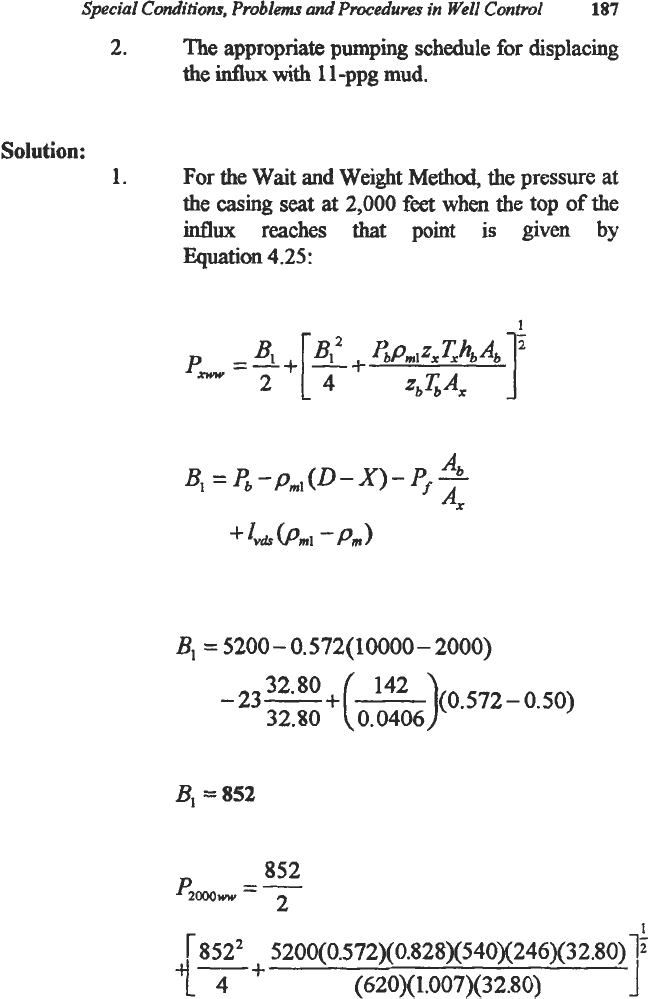
Special
Conditions,
Problems
and
Procedures
in
Well
Control
187
2. The
appropriate
pumping schedule
for
displacing
the
influx
with
1
l-ppg
mud.
Solution:
1.
For
the Wait
and
Weight
Method,
the
pressure
at
the
casing
seat
at
2,000
feet
when
the
top of the
influx
reaches
that
point
is
given
by
Equation
4.25:
B,
=
5200-0.572(1OOO0-2000)
-23-+
:::::
(
-
0.z6)(0.572
-
0.50)
B,
=852
I
r
8
522
5200(
0.5
72)( 0.828)(540)(246)(
3
2.80)
15
1
+
st4
(620)(
1.007)(32.80)
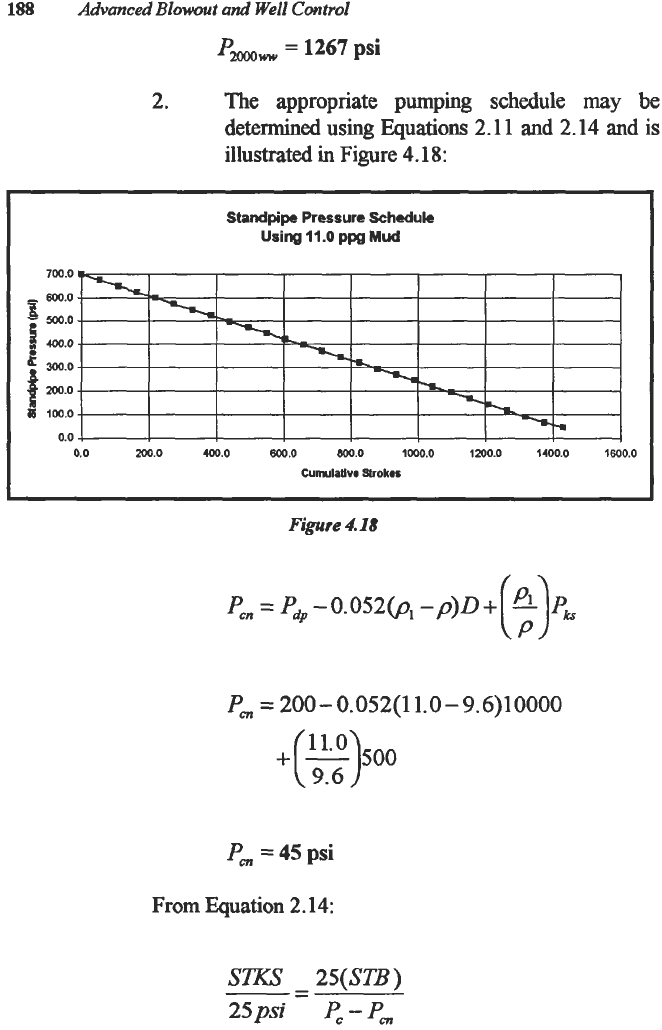
188
Advanced
Blowout
and
Well
Control
PmWw
=
1267
psi
2. The
appropriate pumping
schedule
may
be
determined using Equations
2.1
1
and
2.14
and
is
illustrated in
Figure 4.18:
700.0
800.0
3
500.0
B
m.0
i
20"
PI
100.0
0.0
Standpipe
Pressure
Scheduk
Using
11.0 ppg
Mud
700.0
800.0
3
500.0
B
m.0
i
20"
PI
100.0
0.0
0.0
200.0
4W.0
800.0
WO.0 1000.0 1200.0
1400.0
lWO.O
0.0
200.0
4W.0
800.0
WO.0 1000.0 1200.0
1400.0
lWO.O
Curnulatlvr
Strokes
Figure
4.
I8
e,,
=
Pdp-0.052(p,
-p)D+
fi
Ph
(PI
P,
=
200
-
0.052(11.0
-
9.6)lOOOO
P,
=
45
psi
From
Equation
2.14:
SlKS
-
25(STB)
25psi
P,-P,
--
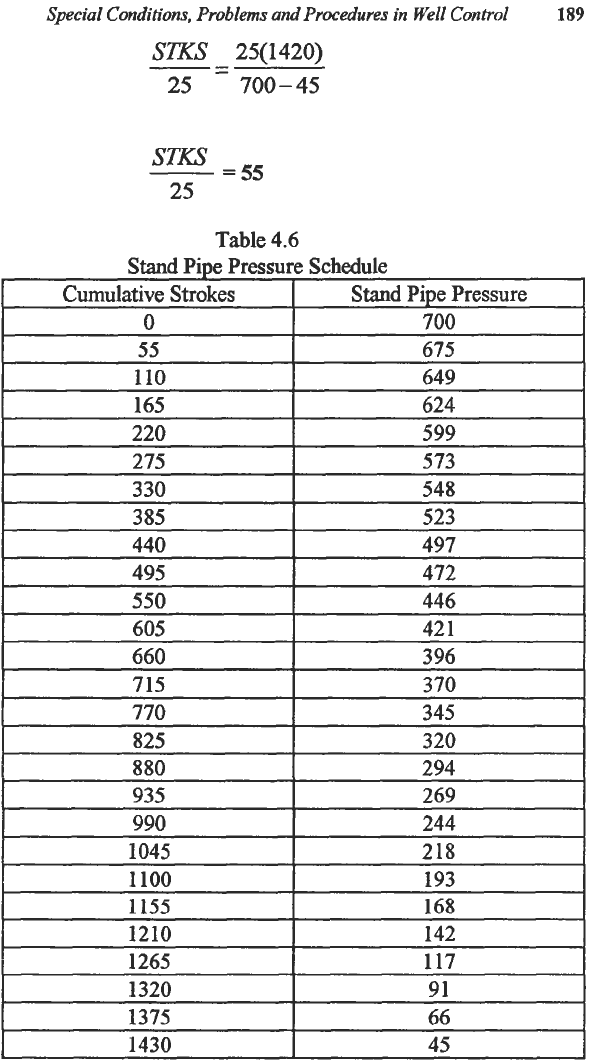
Special Conditions, Problems and Procedures in Well Control
189
SlxS
25(1420)
-
25 700-45
=
55
STY3
25
Table
4.6
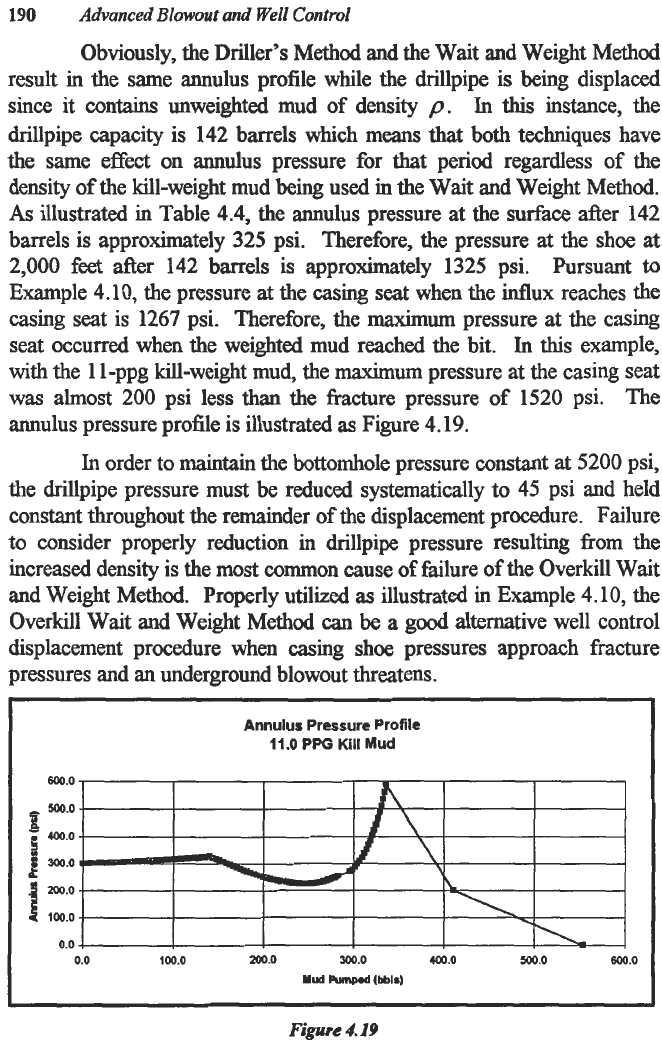
190
Advanced
Blowout
and
Well
Control
Obviously, the Driller's Method and the Wait and Weight
Method
result in the same annulus profile while the drillpipe
is
being
displaced
since it
contains
unweighted mud of density
p.
In
this
instance, the
drillpipe capacity is 142 barrels which means that both techniques have
the same effect on annulus pressure for
that
period regardless of the
density of the kill-weight mud being used
in
the Wait and Weight Method.
As
illustrated in Table 4.4, the annulus pressure at the surfice after 142
barrels is approximately 325 psi. Therefore, the pressure at the shoe
at
2,000 feet after 142 barrels is approximately 1325 psi. Pursuant
to
Example 4.10, the pressure
at
the
casing
seat when the influx reaches the
casing seat is 1267 psi. Therefore, the
maximum
pressure at the casing
seat occurred when the weighted mud reached the bit.
In
this
example,
with
the 1 1-ppg kill-weight mud, the
maximum
pressure
at
the casing seat
was
almost
200 psi less
than
the fracture pressure of
1520
psi. The
annulus pressure profile
is
illustrated
as
Figure 4.19.
In
order to maintain the bottomhole pressure constant at 5200 psi,
the drillpipe pressure must be reduced systematically
to
45 psi and held
constant throughout the remainder of the displacement procedure. Failure
to consider properly reduction in drillpipe pressure resulting
from
the
increased density is the
most
common cause of failure of the Overkill Wait
and Weight
Method.
Properly utilized
as
illustrated in Example 4.10, the
Overkill Wait and Weight Method
can
be
a good alternative well control
displacement procedure when casing
shoe pressures approach fracture
pressures and an underground blowout threatens.
I
Annulus Pressure Profile
11.0
PPG
Kill
Mud
600.0
I
500.0
-
400.0
f
f
m.0
1
::I
0.0
0.0
100.0
200.0
300.0
400.0
500.0
600.0
Mud
RWn0.a
(bblS)
~~ ~
Figure
4.19
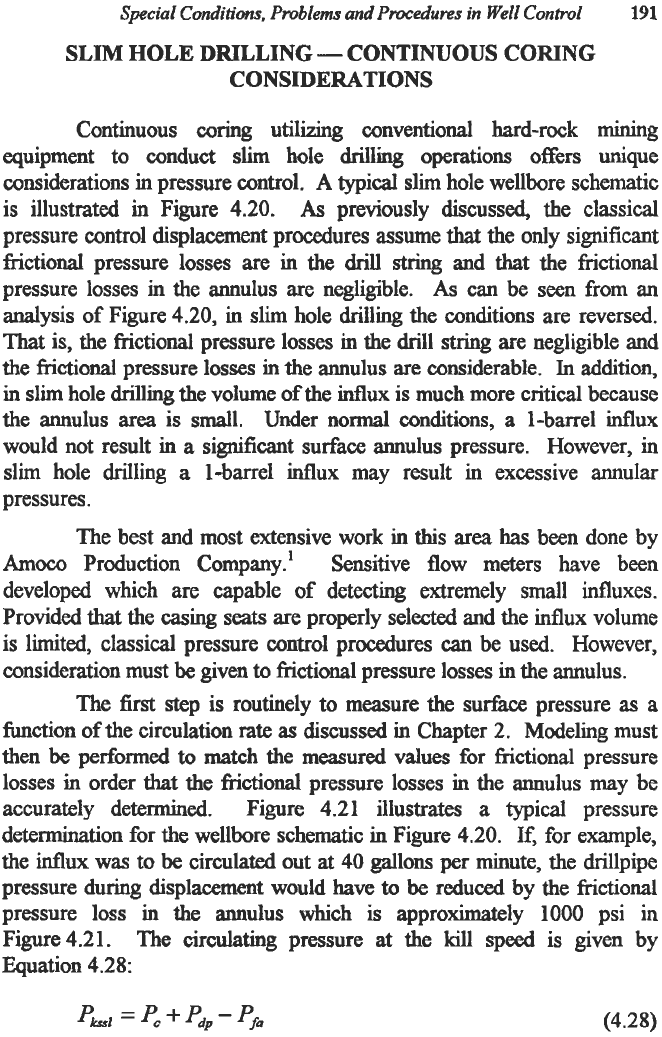
Special Conditions.
Problems
and
procedure^
in
Well
Control
191
SLIM HOLE DRILLING
-
CONTINUOUS CORING
CONSIDERATIONS
Continuous wring utilizing
conventional
hard-rock mining
equipment
to
conduct
slim
hole drilling
operations
offers unique
considedons in pressure
umtrol.
A
typical
slim
hole wellbore schematic
is illustrated in Figure 4.20.
As
previously
discussed,
the classical
pressure control displacement procedures assume
that
the
only
significant
frictional pressure losses are in the drill
string
and
that
the fiictional
pressure losses
in
the annulus are negligible.
As
can be
seen
from an
analysis
of
Figure 4.20, in slim hole drilling the conditions are reversed.
That
is,
the
fiictional
pressure losses
in
the drill string are negligible
and
the
fiictional
pressure losses
in
the
annulus
are
considerable.
In
addition,
in
slim hole drilling the volume of the influx is much more critical because
the annulus area is small. Under normal conditions, a l-barrel influx
would not result
in
a
significant surface annulus pressure. However, in
slim hole drilling
a
1-barrel
influx
may result in excessive annular
pressures.
The
best
and
most
extensive work
in
this
area
has
been
done by
Amm
Production Company.’ Sensitive flow meters have been
developed which are capable
of
detecting extremely
small
influxes.
Provided
that
the
casing
seats
are properly selected and the
influx
volume
is
limited, classical pressure control procedures can be used. However,
consideration must
be
given
to
frictional pressure losses in the annulus.
The
first
step
is
routinely
to
measure
the
surface
pressure
as
a
hction
of
the circulation rate
as
discussed
in Chaptex 2. Modeling must
then
be
performed
to
match
the measured values for frictional pressure
losses
in
order that the
fictional
pressure losses in the annulus
may
be
accurately determined. Figure 4.21 illustrates
a
typical pressure
determination for the wellbore schematic
in
Figure 4.20. If, for example,
the
influx
was
to
be
circulated
out
at
40 gallons per minute, the drillpipe
pressure
dunng
displacement would
haw
to
be
reduced
by
the
frictional
pressure
loss
in the annulus
which
is
approximately
1000
psi in
Figure 4.21. The circulating pressure
at
the kill speed is given by
Equation 4.28:
(4.28)
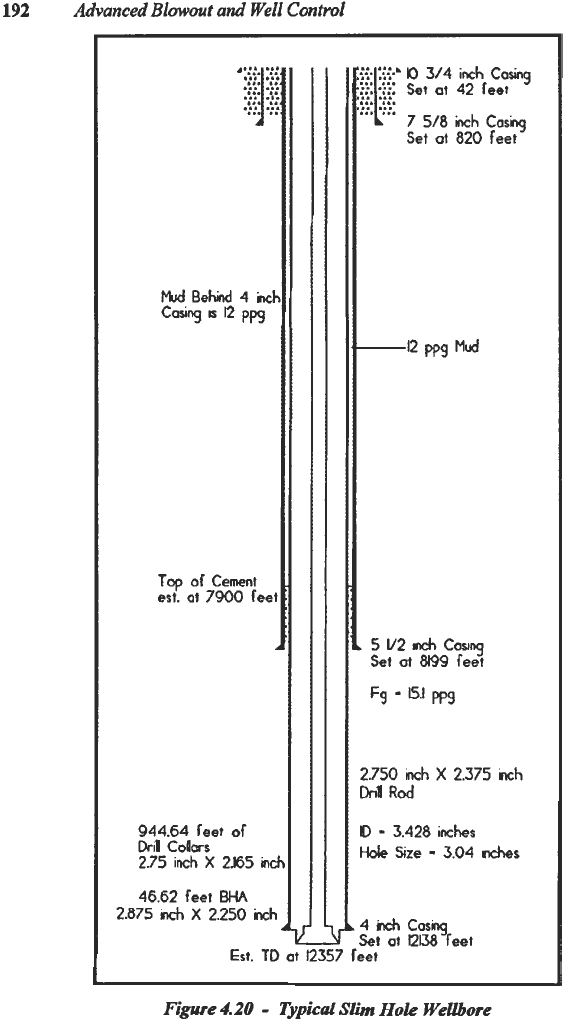
192
Advanced
Blowart
and
Well
Control
Mud
Behind 4
id
Casing
IS
12
ppg
Top
of
Cement
est.
at
7900
feet
944.64 feet
of
Dril
Colars
2.75
inch
X
2365
inc
46.62 feet
BHA
2.875
kh
X
2.250
inch
Est.
TD
at
1235;
7
518
inch
Casi
Set at 820 feet
-12
ppg
Mud
L
5
v2
nch
COSlng
Set
at
8199
feet
Fg
-
15.1
ppg
2.750
hch
X
2.375
kch
Drl
Rod
D
-
3.428
inches
Hde
Size
-
3.04
nches
4
Inch
Casng
Set
ai
I2138
feet
eet
Figure
4.20
-
Typical
SIim
Hole
WeUbore
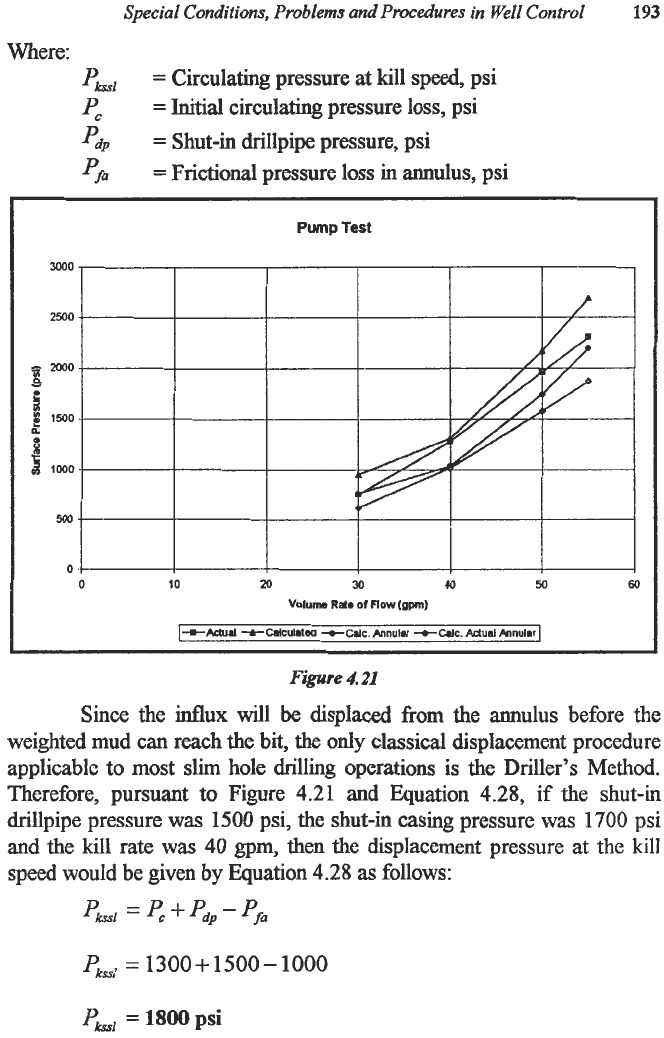
Special Conditions,
Problems
and
Procedures
in
Well
Control
193
Where:
Yhl
P,
pdp
pfi
=
Circulating pressure
at
kill speed, psi
=
Initial
circulating pressure
loss,
psi
=
Shut-in drillpipe pressure, psi
=
Frictional pressure
loss
in annulus, psi
Pump
Test
0
10
20
30 40
50
Voluma
Rae
of
now
(gpml
I-m-Aclual
-+Calculated
-o-
Wc.
Annular
+We.
Actual
Annular
~~ ~~
Figure
4.21
Since the influx
will
be
displaced
from
the annulus bcfore the
weighted mud can reach the bit, the
only
classical displacement procedure
applicablc to most slim hole drilling operations is the Driller’s
Method.
Therefore, pursuant to Figure 4.21 and Equation
4.28,
if the shut-in
drillpipe pressure was
1500 psi, the shut-in casing pressure
was
1700 psi
and the kill rate
was
40 gpm, then the displacement pressure at
the
kill
speed would be given
by
Equation 4.28
as
follows:
Pkl
=
P,
+
Pdp
-
Pfa
PkSl
=
1300+1500-1000
P’,
=
1800
psi
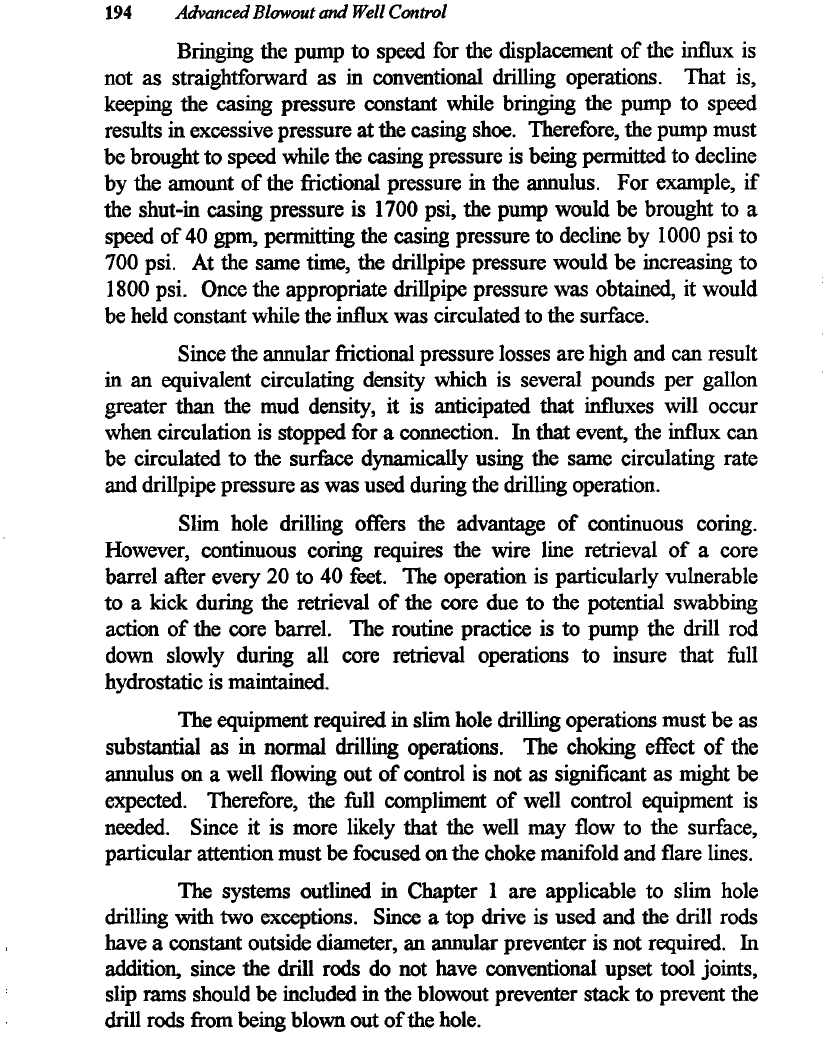
194
Advanced
Blowout
and
Well
Control
Bringing the pump
to
speed for the displacement of the influx is
not
as
straightforward
as
in conventional drilling operations.
That
is,
keeping the casing pressure constant while bringing the pump to speed
results in excessive pressure
at
the casing shoe. Therefore, the pump must
be brought to speed while the casing pressure is being
permitted
to decline
by the amount
of
the frictional pressure in the annulus. For example, if
the shut-in casing pressure is
1700
psi, the pump would be brought to a
speed
of
40
gpm, permitting the casing pressure
to
decline by
1000
psi to
700
psi. At the same time, the drillpipe pressure would be increasing to
1800 psi. Once the appropriate drillpipe pressure
was
obtained, it would
be held constant while the
influx
was circulated to the surf-ace.
Since the annular frictional pressure losses are high and can result
in
an equivalent circulating density which is several pounds per gallon
greater
than
the mud density, it is anticipated
that
influxes will occur
when circulation is stopped for
a
connection.
In
that
event, the influx can
be circulated to the surface dynamically using the same circulating rate
and drillpipe pressure
as
was used during the drilling operation.
Slim hole drilling offers the advantage of continuous coring.
However, continuous
coring
requires the wire line retrieval of a core
barrel after every
20
to
40
feet. The operation is particularly vulnerable
to a
kick
during
the retrieval
of
the core due to the potential swabbing
action
of
the core barrel. The routine practice is to pump the drill rod
down slowly during all core retrieval operations
to
insure
that
fill
hydrostatic
is
maintained.
The equipment required in slim hole drilling operations must be
as
substantial
as
in
normal
drilling
operations. The choking effect
of
the
annulus
on
a well flowing out of control
is
not
as
significant as might be
expected. Therefore, the full compliment of well control equipment is
needed. Since it is more likely
that
the
well may flow to the surface,
particular attention must be focused on the choke manifold and flare lines.
The systems outlined in Chapter
1
are applicable to slim hole
drilling with
two
exceptions. Since
a
top drive is used and the drill rods
have
a
constant outside diameter, an annular preventer is not required.
In
addition, since the drill
rods
do not have conventional upset tool joints,
slip
rams
should be included
in
the blowout preventer
stack
to
prevent the
drill rods
from
being blown out of the hole.
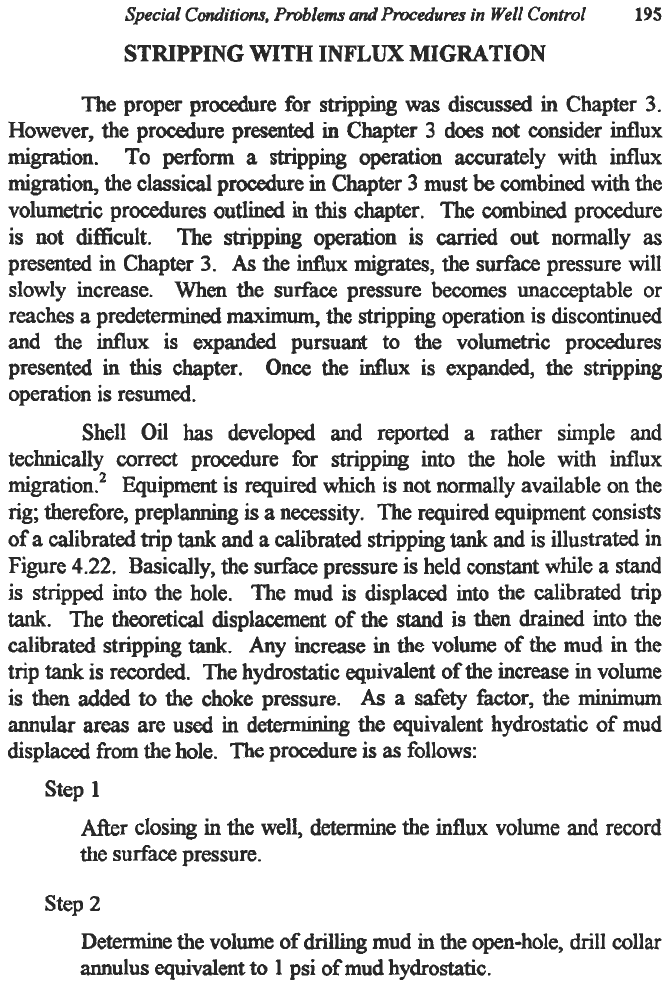
Special
Cditim,
Problems
and
Pmcedures
in
Well
Control
195
STRIPPING WITH INFLUX MIGRATION
The
proper
procedure
fir
stripping
was
discussed
in
Chapter
3.
However, the procedure presented in Chapter
3
does not consider
influx
migration.
To
perform
a
stripping operation accurately with influx
migration, the classical procedure in Chapter
3
must
be
combined with the
volumetric procedures outlined
in
this
chapter. The combined procedure
is
not
difficult.
The stripping
operation
is
carried out
normally
as
presented
in
Chapter
3.
As
the influx
migrates,
the
surface
pressure will
slowly increase.
When the
surfhe
pressure becomes unacceptable or
reaches a predetermined
maximum,
the stripping operation is discontinued
and the
influx
is expanded pursuant to
the
volumetric procedures
presented in
this
chapter.
Once
the
influx
is
expanded, the stripping
operation
is
resumed.
Shell Oil
has
developed
and
reported
a rather simple and
technically correct procedure for stripping into the hole with
influx
migration? Equipment
is
required
which
is
not normally available on the
rig;
therefore, preplaming
is
a
necessity. The requid equipment
consists
of
a
calibrated trip
tank
and
a
calibrated
stripping
tank
and
is
illustrated
in
Figure
4.22.
Basically, the
surface
pressure
is
held
constant
while a
stand
is
stripped into the hole.
The
mud is displaced
into
the calibrated trip
tank.
The
theoretical displacement of the stand is then drained into the
calibrated stripping
tank.
Any
increase
in
the
volume
of
the
mud in
the
trip
tank
is
recorded. The hydrostatic equivalent
of
the
increase
in volume
is
then
added
to
the choke pressure.
As
a
safii
factor, the
minimum
annular
areas
are
used
in
determining
the equivalent hydrostatic of mud
displaced
from
the hole. The procedure is
as
follows:
step1
After dosing in the well, determine the influx volume and record
the
surface pressure.
step
2
Determine
the volume
of
drilling
mud
in the open-hole, drill collar
annulus equivalent
to
1
psi of mud hydrostatic.
